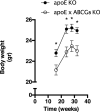In vitro effects of sitosterol and sitostanol on mitochondrial respiration in human brown adipocytes, myotubes and hepatocytes
- PMID: 31317217
- PMCID: PMC7351807
- DOI: 10.1007/s00394-019-02052-y
In vitro effects of sitosterol and sitostanol on mitochondrial respiration in human brown adipocytes, myotubes and hepatocytes
Abstract
Purpose: Lowering of LDL cholesterol levels by plant sterols and stanols is associated with decreased risk of cardiovascular disease in humans. Plant sterols and stanols also lower triacylglycerol (TG). However, it is not fully understood how reduction in TG is achieved and what the full potential of plant sterols and stanols is on whole-body metabolism. We here hypothesize that high levels of plant sterols and stanols stimulate whole-body energy expenditure, which can be attributed to changes in mitochondrial function of brown adipose tissue (BAT), skeletal muscle and liver.
Methods: Phytosterolemic mice were fed chow diets for 32 weeks to examine whole-body weight gain. In vitro, 24-h incubation were performed in adipocytes derived from human BAT, human myotubes or HepG2 human hepatocytes using sitosterol or sitostanol. Following mitochondrial function was assessed using seahorse bioanalyzer.
Results: Chow feeding in phytosterolemic mice resulted in diminished increase in body weight compared to control mice. In vitro, sitosterol or sitostanol did not change mitochondrial function in adipocytes derived from human BAT or in cultured human myotubes. Interestingly, maximal mitochondrial function in HepG2 human hepatocytes was decreased following sitosterol or sitostanol incubation, however, only when mitochondrial function was assessed in low glucose-containing medium.
Conclusions: Beneficial in vivo effects of plant sterols and stanols on lipid and lipoprotein metabolism are well recognized. Our results indicate that alterations in human mitochondrial function are apparently not involved to explain these beneficial effects.
Keywords: Brown adipose tissue; Cellular respiration; Mitochondria; Sitostanol; Sitosterol.
Conflict of interest statement
The authors declare that they have no conflict of interest.
Figures




References
-
- Gylling H, Plat J, Turley S, Ginsberg HN, Ellegard L, Jessup W, Jones PJ, Lutjohann D, Maerz W, Masana L, Silbernagel G, Staels B, Boren J, Catapano AL, De Backer G, Deanfield J, Descamps OS, Kovanen PT, Riccardi G, Tokgozoglu L, Chapman MJ. Plant sterols and plant stanols in the management of dyslipidaemia and prevention of cardiovascular disease. Atherosclerosis. 2014;232(2):346–360. doi: 10.1016/j.atherosclerosis.2013.11.043. - DOI - PubMed
-
- Hegele RA, Ginsberg HN, Chapman MJ, Nordestgaard BG, Kuivenhoven JA, Averna M, Boren J, Bruckert E, Catapano AL, Descamps OS, Hovingh GK, Humphries SE, Kovanen PT, Masana L, Pajukanta P, Parhofer KG, Raal FJ, Ray KK, Santos RD, Stalenhoef AF, Stroes E, Taskinen MR, Tybjaerg-Hansen A, Watts GF, Wiklund O. The polygenic nature of hypertriglyceridaemia: implications for definition, diagnosis, and management. Lancet Diabetes Endocrinol. 2014;2(8):655–666. doi: 10.1016/S2213-8587(13)70191-8. - DOI - PMC - PubMed
MeSH terms
Substances
Grants and funding
LinkOut - more resources
Full Text Sources
Miscellaneous

